ePortfolio Artifact 11: Mechanical Engineering Competencies and Skills
VerifiedAdded on 2020/04/15
|11
|2385
|247
Project
AI Summary
This ePortfolio artifact, created by a mechanical engineering student, provides a comprehensive overview of their academic and professional development. It showcases the student's engagement with key competencies, including communication skills, critical and creative thinking, leadership abilities, teamwork, professionalism, and technological proficiency. The artifact details specific assignments and projects undertaken, such as describing mechanical engineering, informative speeches, analyzing advertisements, nuclear energy debates, leadership traits, textbook presentations, teamwork necessities, group projects, workplace ethics, diversity in the workplace, presentations, and C++ programming. Each section includes a brief introduction to the task, a reflection on the learning experience, and suggestions for future improvements, demonstrating the student's ability to synthesize knowledge and apply it to real-world scenarios. The references provided further support the student's understanding and application of the core concepts within mechanical engineering and related fields.
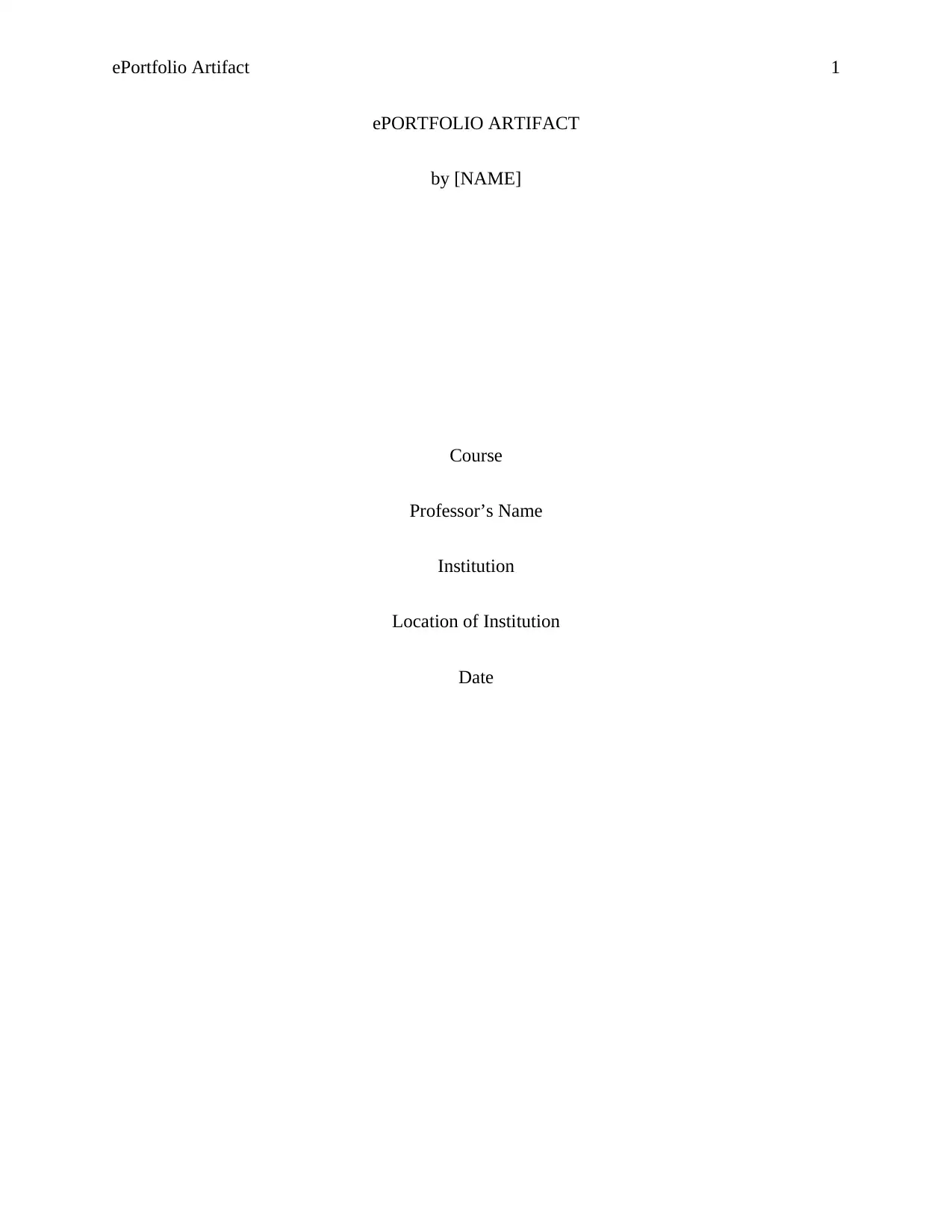
ePortfolio Artifact 1
ePORTFOLIO ARTIFACT
by [NAME]
Course
Professor’s Name
Institution
Location of Institution
Date
ePORTFOLIO ARTIFACT
by [NAME]
Course
Professor’s Name
Institution
Location of Institution
Date
Paraphrase This Document
Need a fresh take? Get an instant paraphrase of this document with our AI Paraphraser
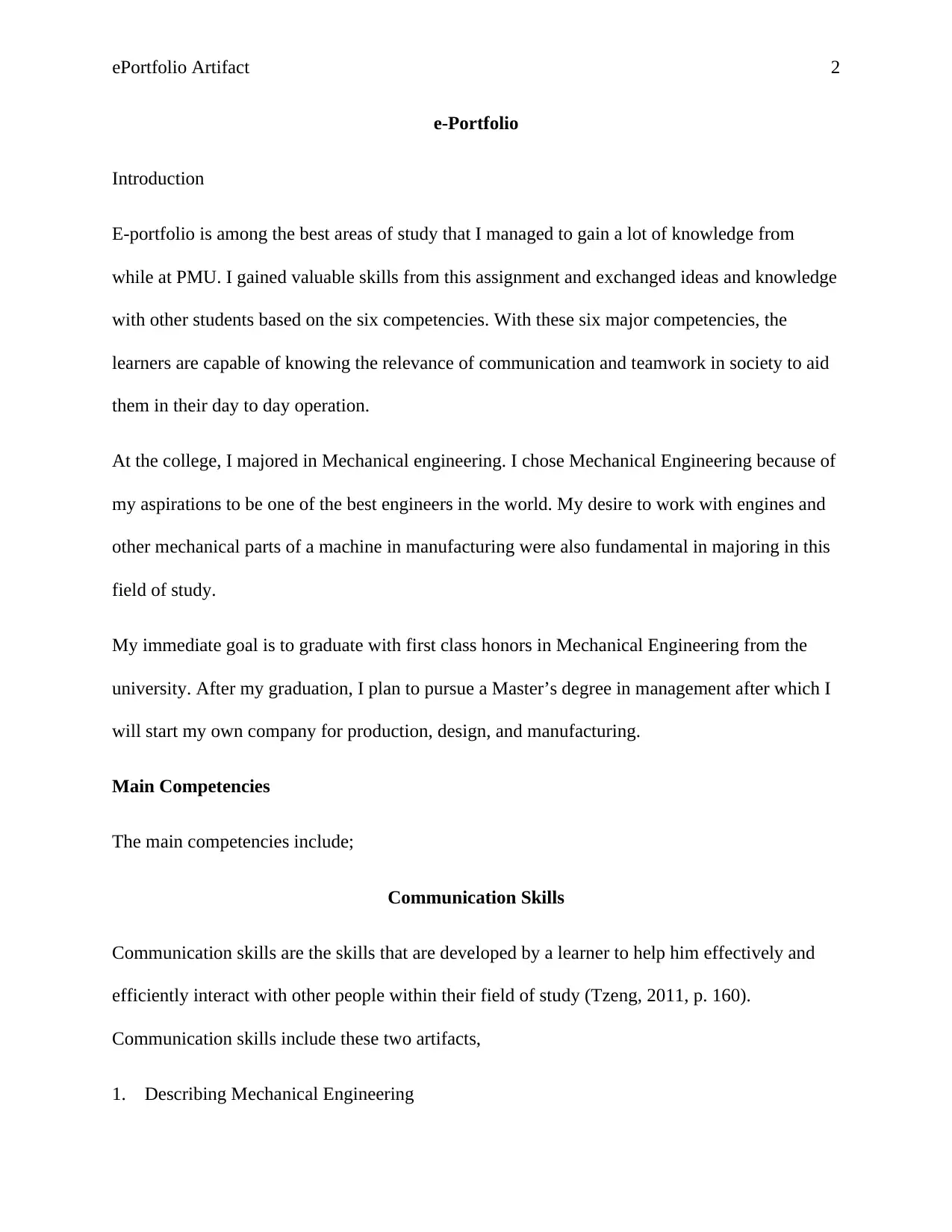
ePortfolio Artifact 2
e-Portfolio
Introduction
E-portfolio is among the best areas of study that I managed to gain a lot of knowledge from
while at PMU. I gained valuable skills from this assignment and exchanged ideas and knowledge
with other students based on the six competencies. With these six major competencies, the
learners are capable of knowing the relevance of communication and teamwork in society to aid
them in their day to day operation.
At the college, I majored in Mechanical engineering. I chose Mechanical Engineering because of
my aspirations to be one of the best engineers in the world. My desire to work with engines and
other mechanical parts of a machine in manufacturing were also fundamental in majoring in this
field of study.
My immediate goal is to graduate with first class honors in Mechanical Engineering from the
university. After my graduation, I plan to pursue a Master’s degree in management after which I
will start my own company for production, design, and manufacturing.
Main Competencies
The main competencies include;
Communication Skills
Communication skills are the skills that are developed by a learner to help him effectively and
efficiently interact with other people within their field of study (Tzeng, 2011, p. 160).
Communication skills include these two artifacts,
1. Describing Mechanical Engineering
e-Portfolio
Introduction
E-portfolio is among the best areas of study that I managed to gain a lot of knowledge from
while at PMU. I gained valuable skills from this assignment and exchanged ideas and knowledge
with other students based on the six competencies. With these six major competencies, the
learners are capable of knowing the relevance of communication and teamwork in society to aid
them in their day to day operation.
At the college, I majored in Mechanical engineering. I chose Mechanical Engineering because of
my aspirations to be one of the best engineers in the world. My desire to work with engines and
other mechanical parts of a machine in manufacturing were also fundamental in majoring in this
field of study.
My immediate goal is to graduate with first class honors in Mechanical Engineering from the
university. After my graduation, I plan to pursue a Master’s degree in management after which I
will start my own company for production, design, and manufacturing.
Main Competencies
The main competencies include;
Communication Skills
Communication skills are the skills that are developed by a learner to help him effectively and
efficiently interact with other people within their field of study (Tzeng, 2011, p. 160).
Communication skills include these two artifacts,
1. Describing Mechanical Engineering
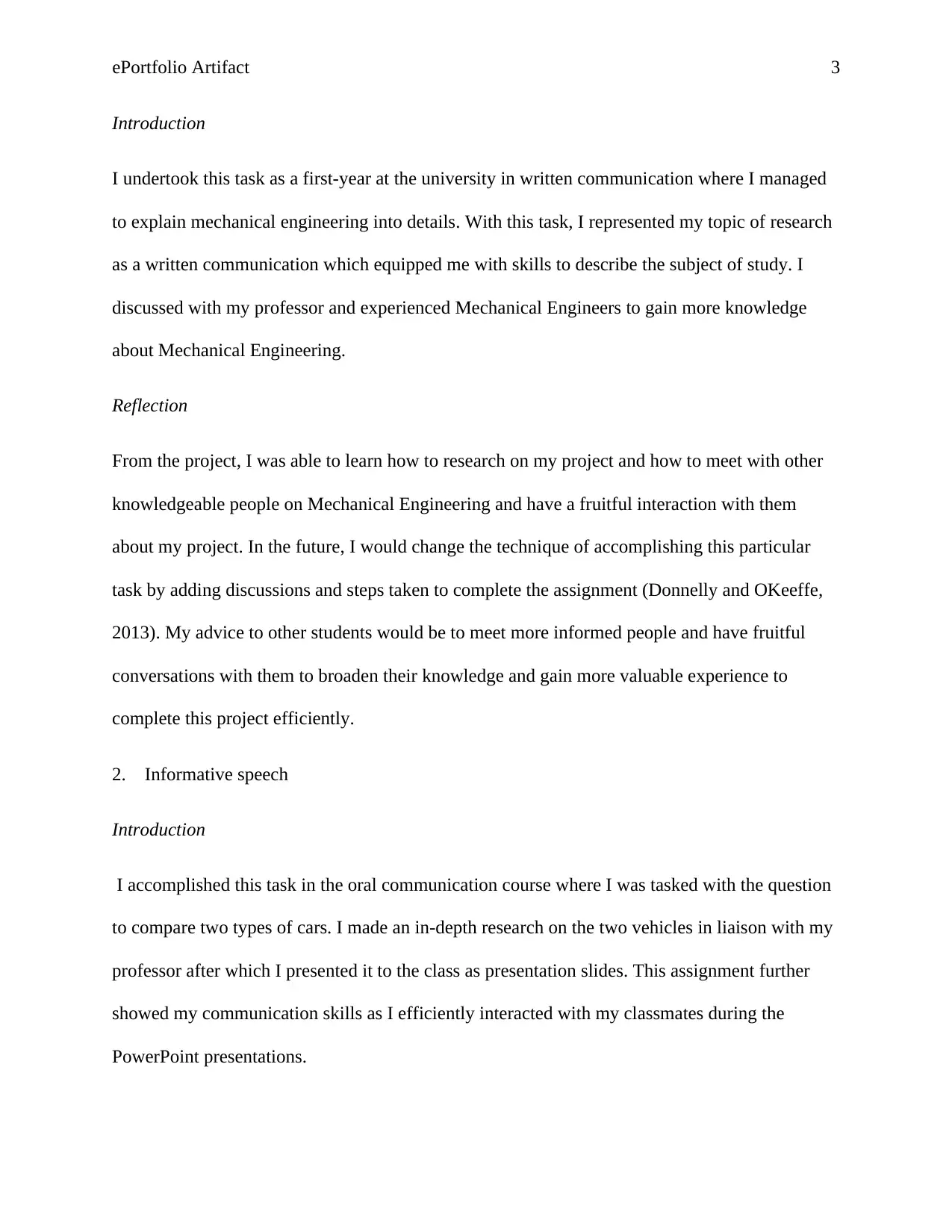
ePortfolio Artifact 3
Introduction
I undertook this task as a first-year at the university in written communication where I managed
to explain mechanical engineering into details. With this task, I represented my topic of research
as a written communication which equipped me with skills to describe the subject of study. I
discussed with my professor and experienced Mechanical Engineers to gain more knowledge
about Mechanical Engineering.
Reflection
From the project, I was able to learn how to research on my project and how to meet with other
knowledgeable people on Mechanical Engineering and have a fruitful interaction with them
about my project. In the future, I would change the technique of accomplishing this particular
task by adding discussions and steps taken to complete the assignment (Donnelly and OKeeffe,
2013). My advice to other students would be to meet more informed people and have fruitful
conversations with them to broaden their knowledge and gain more valuable experience to
complete this project efficiently.
2. Informative speech
Introduction
I accomplished this task in the oral communication course where I was tasked with the question
to compare two types of cars. I made an in-depth research on the two vehicles in liaison with my
professor after which I presented it to the class as presentation slides. This assignment further
showed my communication skills as I efficiently interacted with my classmates during the
PowerPoint presentations.
Introduction
I undertook this task as a first-year at the university in written communication where I managed
to explain mechanical engineering into details. With this task, I represented my topic of research
as a written communication which equipped me with skills to describe the subject of study. I
discussed with my professor and experienced Mechanical Engineers to gain more knowledge
about Mechanical Engineering.
Reflection
From the project, I was able to learn how to research on my project and how to meet with other
knowledgeable people on Mechanical Engineering and have a fruitful interaction with them
about my project. In the future, I would change the technique of accomplishing this particular
task by adding discussions and steps taken to complete the assignment (Donnelly and OKeeffe,
2013). My advice to other students would be to meet more informed people and have fruitful
conversations with them to broaden their knowledge and gain more valuable experience to
complete this project efficiently.
2. Informative speech
Introduction
I accomplished this task in the oral communication course where I was tasked with the question
to compare two types of cars. I made an in-depth research on the two vehicles in liaison with my
professor after which I presented it to the class as presentation slides. This assignment further
showed my communication skills as I efficiently interacted with my classmates during the
PowerPoint presentations.
⊘ This is a preview!⊘
Do you want full access?
Subscribe today to unlock all pages.

Trusted by 1+ million students worldwide
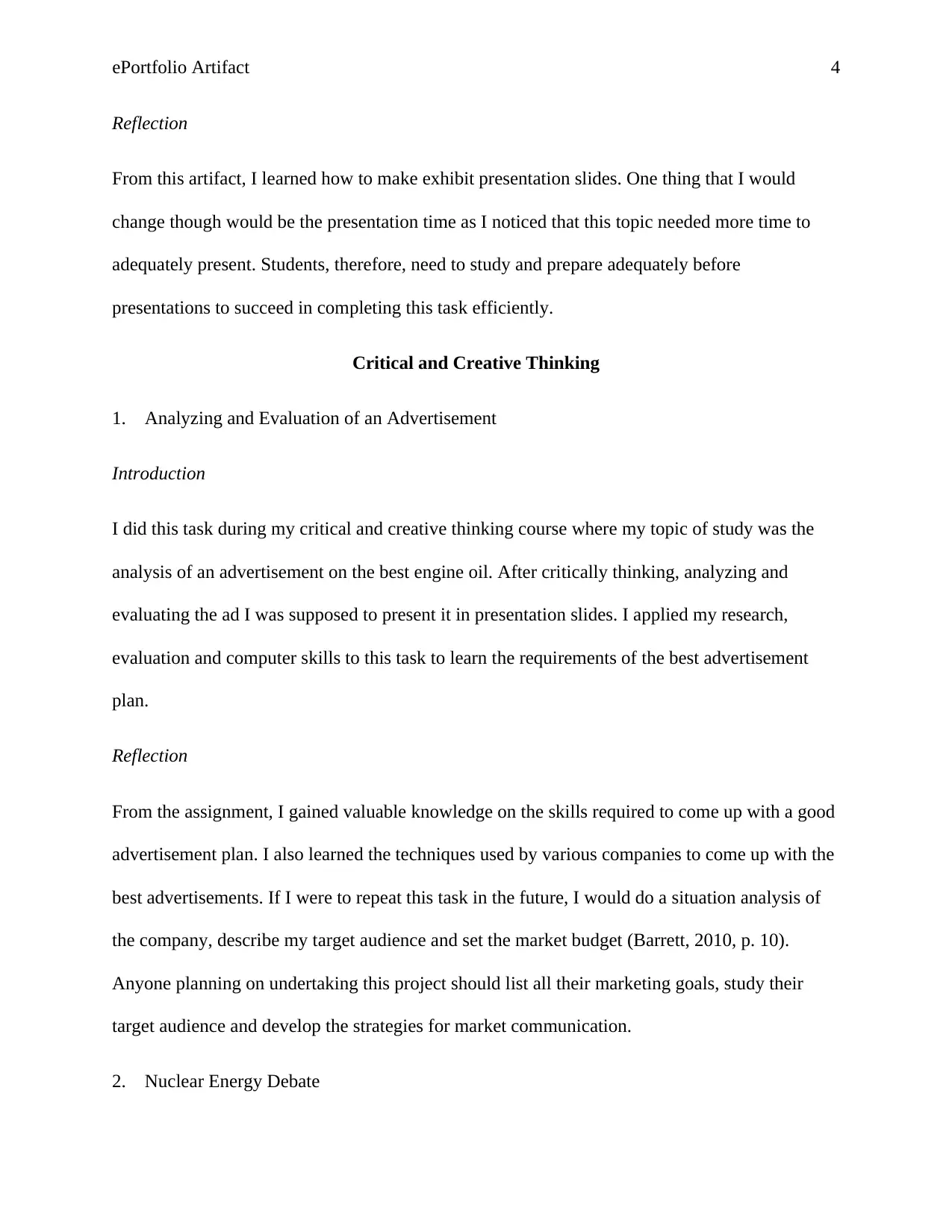
ePortfolio Artifact 4
Reflection
From this artifact, I learned how to make exhibit presentation slides. One thing that I would
change though would be the presentation time as I noticed that this topic needed more time to
adequately present. Students, therefore, need to study and prepare adequately before
presentations to succeed in completing this task efficiently.
Critical and Creative Thinking
1. Analyzing and Evaluation of an Advertisement
Introduction
I did this task during my critical and creative thinking course where my topic of study was the
analysis of an advertisement on the best engine oil. After critically thinking, analyzing and
evaluating the ad I was supposed to present it in presentation slides. I applied my research,
evaluation and computer skills to this task to learn the requirements of the best advertisement
plan.
Reflection
From the assignment, I gained valuable knowledge on the skills required to come up with a good
advertisement plan. I also learned the techniques used by various companies to come up with the
best advertisements. If I were to repeat this task in the future, I would do a situation analysis of
the company, describe my target audience and set the market budget (Barrett, 2010, p. 10).
Anyone planning on undertaking this project should list all their marketing goals, study their
target audience and develop the strategies for market communication.
2. Nuclear Energy Debate
Reflection
From this artifact, I learned how to make exhibit presentation slides. One thing that I would
change though would be the presentation time as I noticed that this topic needed more time to
adequately present. Students, therefore, need to study and prepare adequately before
presentations to succeed in completing this task efficiently.
Critical and Creative Thinking
1. Analyzing and Evaluation of an Advertisement
Introduction
I did this task during my critical and creative thinking course where my topic of study was the
analysis of an advertisement on the best engine oil. After critically thinking, analyzing and
evaluating the ad I was supposed to present it in presentation slides. I applied my research,
evaluation and computer skills to this task to learn the requirements of the best advertisement
plan.
Reflection
From the assignment, I gained valuable knowledge on the skills required to come up with a good
advertisement plan. I also learned the techniques used by various companies to come up with the
best advertisements. If I were to repeat this task in the future, I would do a situation analysis of
the company, describe my target audience and set the market budget (Barrett, 2010, p. 10).
Anyone planning on undertaking this project should list all their marketing goals, study their
target audience and develop the strategies for market communication.
2. Nuclear Energy Debate
Paraphrase This Document
Need a fresh take? Get an instant paraphrase of this document with our AI Paraphraser
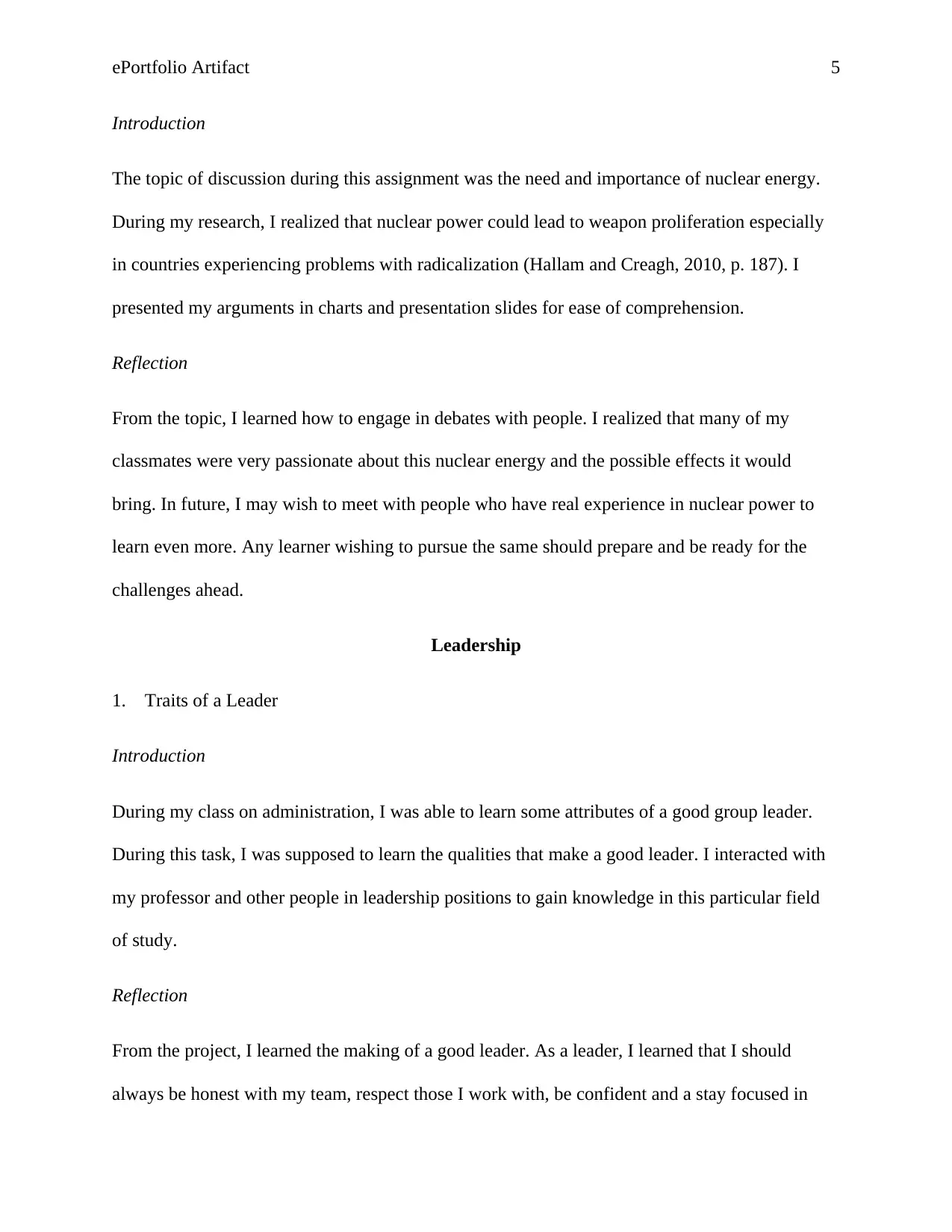
ePortfolio Artifact 5
Introduction
The topic of discussion during this assignment was the need and importance of nuclear energy.
During my research, I realized that nuclear power could lead to weapon proliferation especially
in countries experiencing problems with radicalization (Hallam and Creagh, 2010, p. 187). I
presented my arguments in charts and presentation slides for ease of comprehension.
Reflection
From the topic, I learned how to engage in debates with people. I realized that many of my
classmates were very passionate about this nuclear energy and the possible effects it would
bring. In future, I may wish to meet with people who have real experience in nuclear power to
learn even more. Any learner wishing to pursue the same should prepare and be ready for the
challenges ahead.
Leadership
1. Traits of a Leader
Introduction
During my class on administration, I was able to learn some attributes of a good group leader.
During this task, I was supposed to learn the qualities that make a good leader. I interacted with
my professor and other people in leadership positions to gain knowledge in this particular field
of study.
Reflection
From the project, I learned the making of a good leader. As a leader, I learned that I should
always be honest with my team, respect those I work with, be confident and a stay focused in
Introduction
The topic of discussion during this assignment was the need and importance of nuclear energy.
During my research, I realized that nuclear power could lead to weapon proliferation especially
in countries experiencing problems with radicalization (Hallam and Creagh, 2010, p. 187). I
presented my arguments in charts and presentation slides for ease of comprehension.
Reflection
From the topic, I learned how to engage in debates with people. I realized that many of my
classmates were very passionate about this nuclear energy and the possible effects it would
bring. In future, I may wish to meet with people who have real experience in nuclear power to
learn even more. Any learner wishing to pursue the same should prepare and be ready for the
challenges ahead.
Leadership
1. Traits of a Leader
Introduction
During my class on administration, I was able to learn some attributes of a good group leader.
During this task, I was supposed to learn the qualities that make a good leader. I interacted with
my professor and other people in leadership positions to gain knowledge in this particular field
of study.
Reflection
From the project, I learned the making of a good leader. As a leader, I learned that I should
always be honest with my team, respect those I work with, be confident and a stay focused in
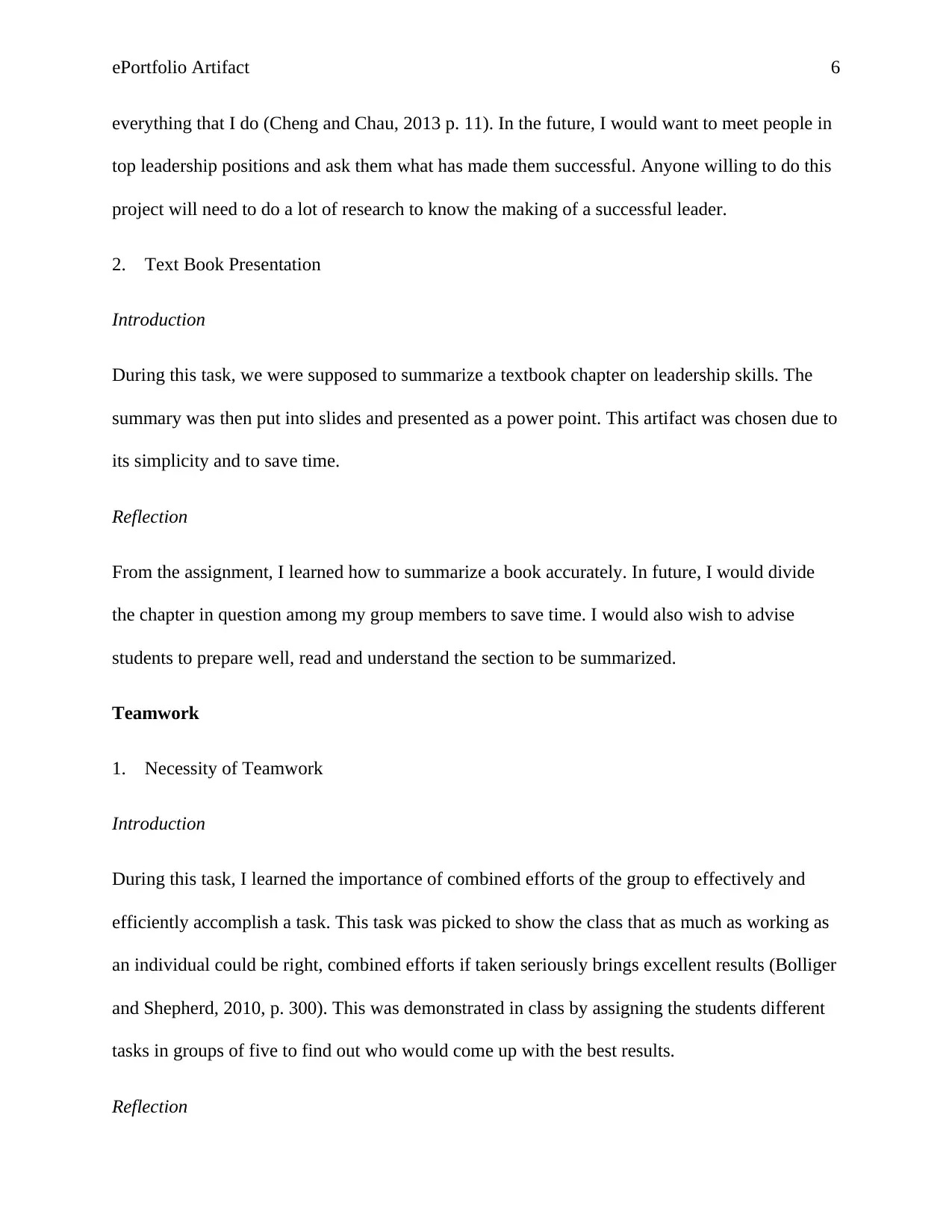
ePortfolio Artifact 6
everything that I do (Cheng and Chau, 2013 p. 11). In the future, I would want to meet people in
top leadership positions and ask them what has made them successful. Anyone willing to do this
project will need to do a lot of research to know the making of a successful leader.
2. Text Book Presentation
Introduction
During this task, we were supposed to summarize a textbook chapter on leadership skills. The
summary was then put into slides and presented as a power point. This artifact was chosen due to
its simplicity and to save time.
Reflection
From the assignment, I learned how to summarize a book accurately. In future, I would divide
the chapter in question among my group members to save time. I would also wish to advise
students to prepare well, read and understand the section to be summarized.
Teamwork
1. Necessity of Teamwork
Introduction
During this task, I learned the importance of combined efforts of the group to effectively and
efficiently accomplish a task. This task was picked to show the class that as much as working as
an individual could be right, combined efforts if taken seriously brings excellent results (Bolliger
and Shepherd, 2010, p. 300). This was demonstrated in class by assigning the students different
tasks in groups of five to find out who would come up with the best results.
Reflection
everything that I do (Cheng and Chau, 2013 p. 11). In the future, I would want to meet people in
top leadership positions and ask them what has made them successful. Anyone willing to do this
project will need to do a lot of research to know the making of a successful leader.
2. Text Book Presentation
Introduction
During this task, we were supposed to summarize a textbook chapter on leadership skills. The
summary was then put into slides and presented as a power point. This artifact was chosen due to
its simplicity and to save time.
Reflection
From the assignment, I learned how to summarize a book accurately. In future, I would divide
the chapter in question among my group members to save time. I would also wish to advise
students to prepare well, read and understand the section to be summarized.
Teamwork
1. Necessity of Teamwork
Introduction
During this task, I learned the importance of combined efforts of the group to effectively and
efficiently accomplish a task. This task was picked to show the class that as much as working as
an individual could be right, combined efforts if taken seriously brings excellent results (Bolliger
and Shepherd, 2010, p. 300). This was demonstrated in class by assigning the students different
tasks in groups of five to find out who would come up with the best results.
Reflection
⊘ This is a preview!⊘
Do you want full access?
Subscribe today to unlock all pages.

Trusted by 1+ million students worldwide
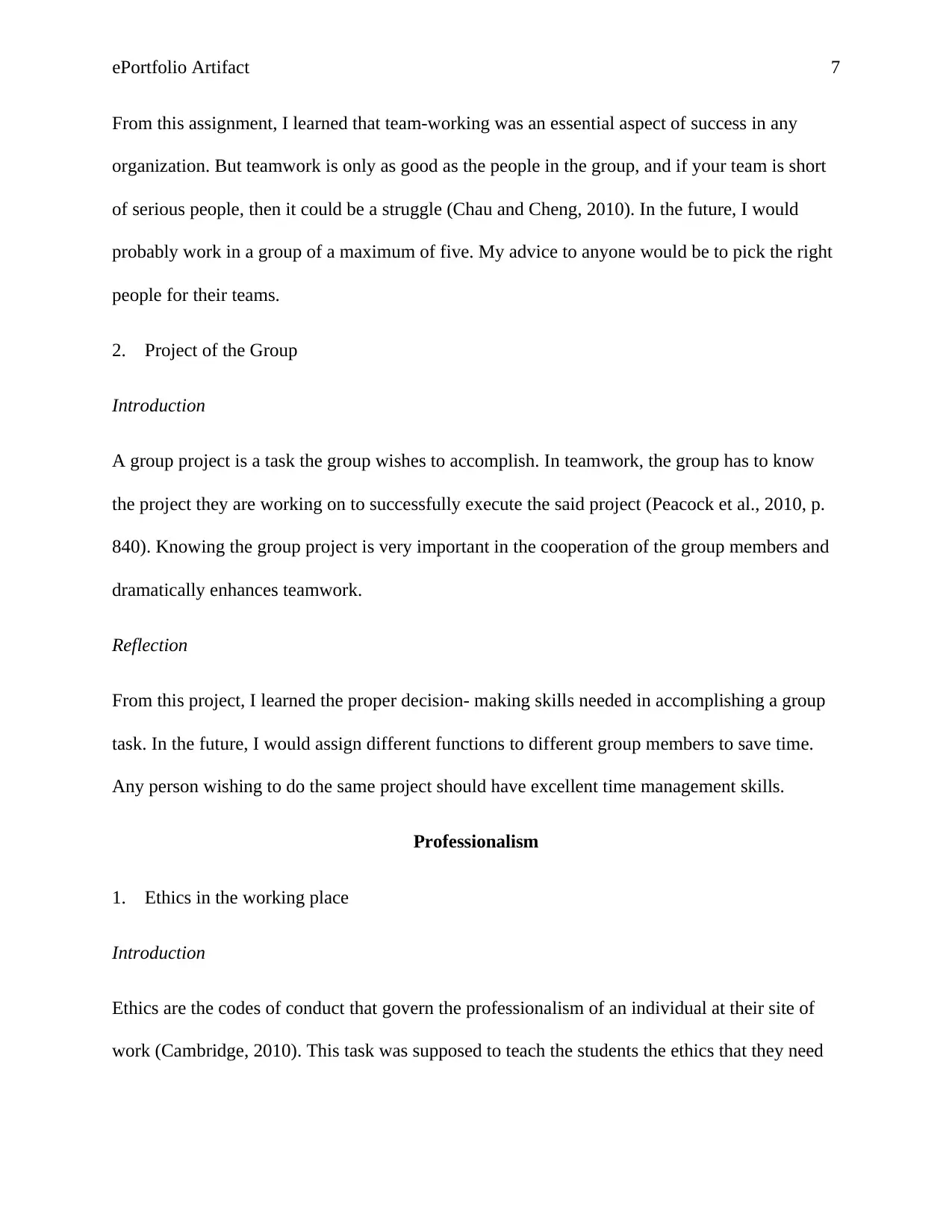
ePortfolio Artifact 7
From this assignment, I learned that team-working was an essential aspect of success in any
organization. But teamwork is only as good as the people in the group, and if your team is short
of serious people, then it could be a struggle (Chau and Cheng, 2010). In the future, I would
probably work in a group of a maximum of five. My advice to anyone would be to pick the right
people for their teams.
2. Project of the Group
Introduction
A group project is a task the group wishes to accomplish. In teamwork, the group has to know
the project they are working on to successfully execute the said project (Peacock et al., 2010, p.
840). Knowing the group project is very important in the cooperation of the group members and
dramatically enhances teamwork.
Reflection
From this project, I learned the proper decision- making skills needed in accomplishing a group
task. In the future, I would assign different functions to different group members to save time.
Any person wishing to do the same project should have excellent time management skills.
Professionalism
1. Ethics in the working place
Introduction
Ethics are the codes of conduct that govern the professionalism of an individual at their site of
work (Cambridge, 2010). This task was supposed to teach the students the ethics that they need
From this assignment, I learned that team-working was an essential aspect of success in any
organization. But teamwork is only as good as the people in the group, and if your team is short
of serious people, then it could be a struggle (Chau and Cheng, 2010). In the future, I would
probably work in a group of a maximum of five. My advice to anyone would be to pick the right
people for their teams.
2. Project of the Group
Introduction
A group project is a task the group wishes to accomplish. In teamwork, the group has to know
the project they are working on to successfully execute the said project (Peacock et al., 2010, p.
840). Knowing the group project is very important in the cooperation of the group members and
dramatically enhances teamwork.
Reflection
From this project, I learned the proper decision- making skills needed in accomplishing a group
task. In the future, I would assign different functions to different group members to save time.
Any person wishing to do the same project should have excellent time management skills.
Professionalism
1. Ethics in the working place
Introduction
Ethics are the codes of conduct that govern the professionalism of an individual at their site of
work (Cambridge, 2010). This task was supposed to teach the students the ethics that they need
Paraphrase This Document
Need a fresh take? Get an instant paraphrase of this document with our AI Paraphraser
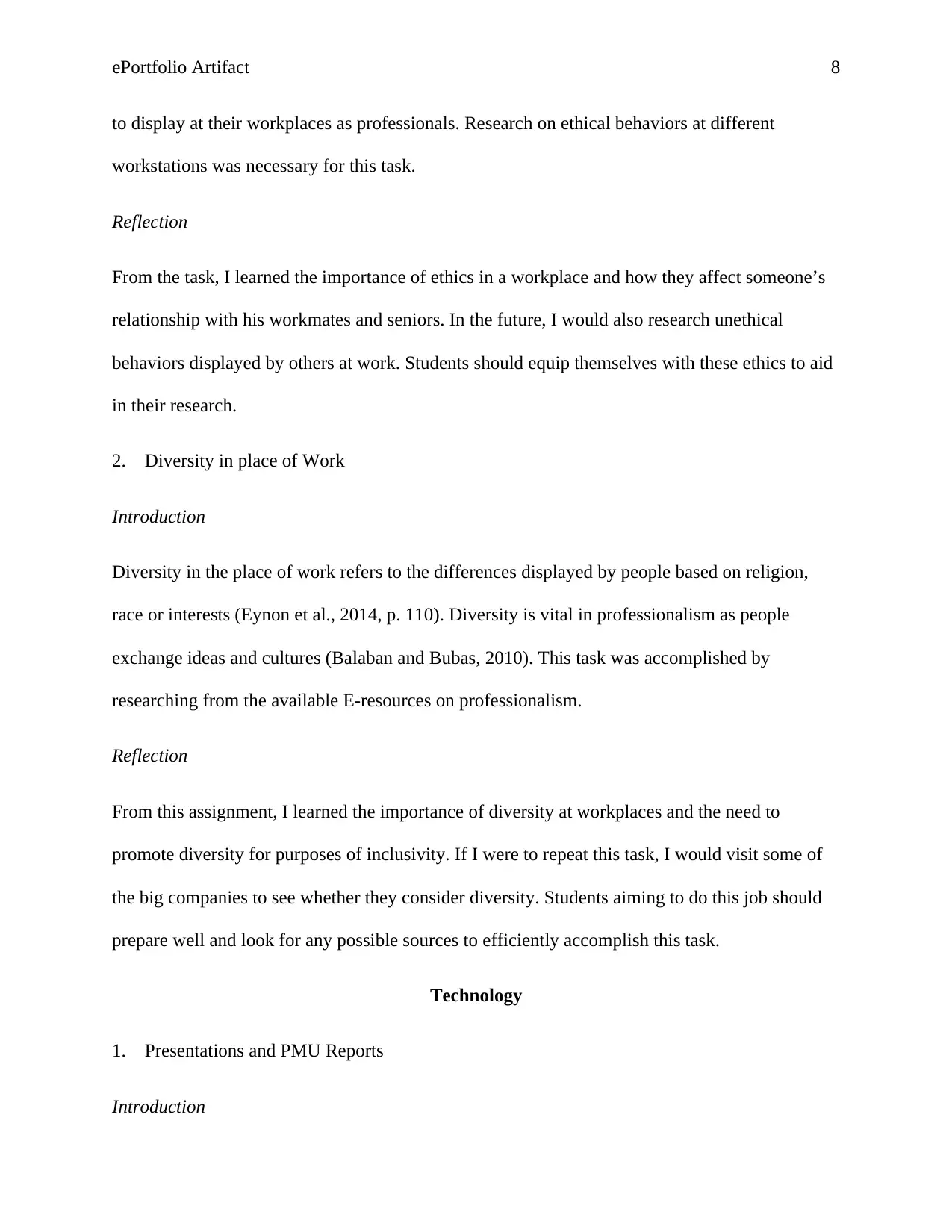
ePortfolio Artifact 8
to display at their workplaces as professionals. Research on ethical behaviors at different
workstations was necessary for this task.
Reflection
From the task, I learned the importance of ethics in a workplace and how they affect someone’s
relationship with his workmates and seniors. In the future, I would also research unethical
behaviors displayed by others at work. Students should equip themselves with these ethics to aid
in their research.
2. Diversity in place of Work
Introduction
Diversity in the place of work refers to the differences displayed by people based on religion,
race or interests (Eynon et al., 2014, p. 110). Diversity is vital in professionalism as people
exchange ideas and cultures (Balaban and Bubas, 2010). This task was accomplished by
researching from the available E-resources on professionalism.
Reflection
From this assignment, I learned the importance of diversity at workplaces and the need to
promote diversity for purposes of inclusivity. If I were to repeat this task, I would visit some of
the big companies to see whether they consider diversity. Students aiming to do this job should
prepare well and look for any possible sources to efficiently accomplish this task.
Technology
1. Presentations and PMU Reports
Introduction
to display at their workplaces as professionals. Research on ethical behaviors at different
workstations was necessary for this task.
Reflection
From the task, I learned the importance of ethics in a workplace and how they affect someone’s
relationship with his workmates and seniors. In the future, I would also research unethical
behaviors displayed by others at work. Students should equip themselves with these ethics to aid
in their research.
2. Diversity in place of Work
Introduction
Diversity in the place of work refers to the differences displayed by people based on religion,
race or interests (Eynon et al., 2014, p. 110). Diversity is vital in professionalism as people
exchange ideas and cultures (Balaban and Bubas, 2010). This task was accomplished by
researching from the available E-resources on professionalism.
Reflection
From this assignment, I learned the importance of diversity at workplaces and the need to
promote diversity for purposes of inclusivity. If I were to repeat this task, I would visit some of
the big companies to see whether they consider diversity. Students aiming to do this job should
prepare well and look for any possible sources to efficiently accomplish this task.
Technology
1. Presentations and PMU Reports
Introduction
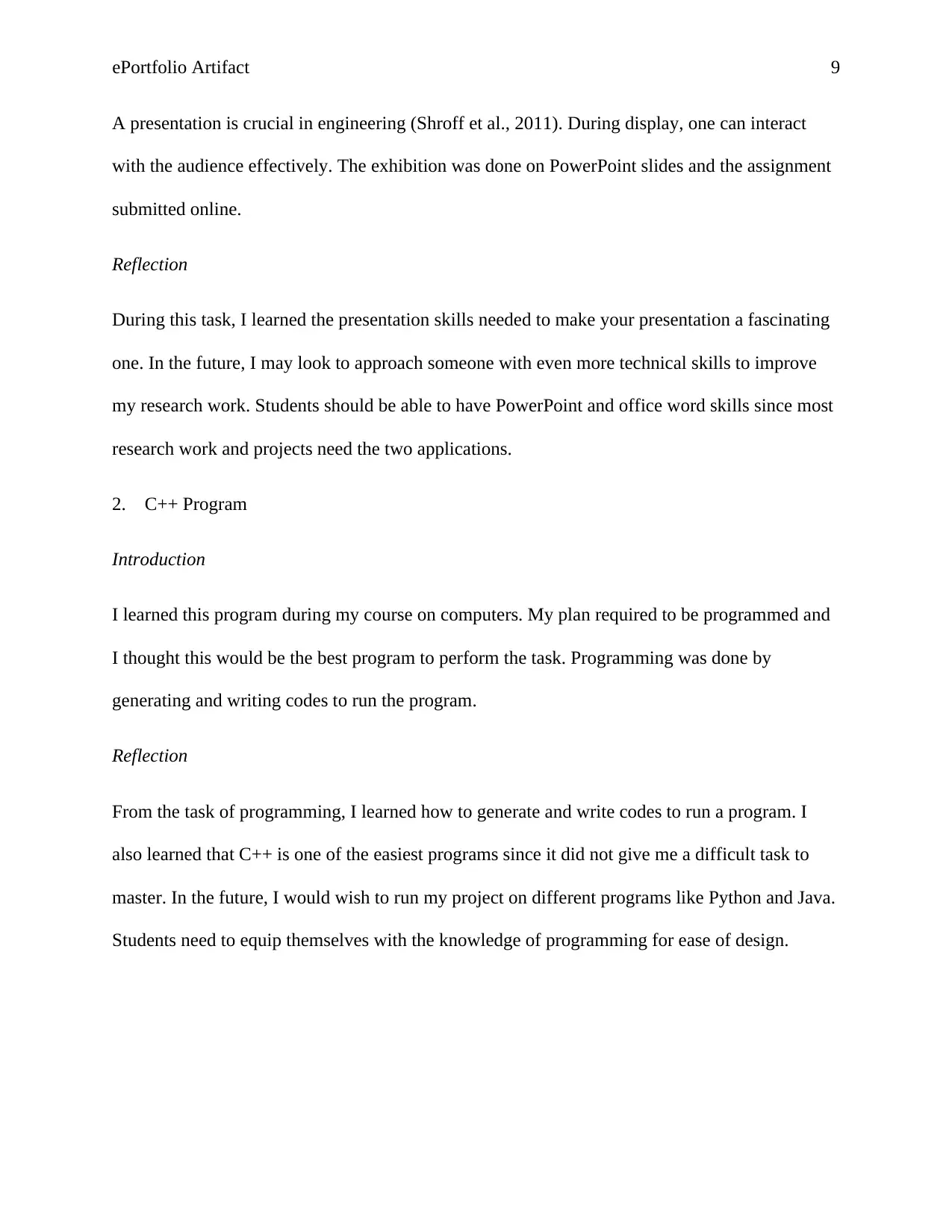
ePortfolio Artifact 9
A presentation is crucial in engineering (Shroff et al., 2011). During display, one can interact
with the audience effectively. The exhibition was done on PowerPoint slides and the assignment
submitted online.
Reflection
During this task, I learned the presentation skills needed to make your presentation a fascinating
one. In the future, I may look to approach someone with even more technical skills to improve
my research work. Students should be able to have PowerPoint and office word skills since most
research work and projects need the two applications.
2. C++ Program
Introduction
I learned this program during my course on computers. My plan required to be programmed and
I thought this would be the best program to perform the task. Programming was done by
generating and writing codes to run the program.
Reflection
From the task of programming, I learned how to generate and write codes to run a program. I
also learned that C++ is one of the easiest programs since it did not give me a difficult task to
master. In the future, I would wish to run my project on different programs like Python and Java.
Students need to equip themselves with the knowledge of programming for ease of design.
A presentation is crucial in engineering (Shroff et al., 2011). During display, one can interact
with the audience effectively. The exhibition was done on PowerPoint slides and the assignment
submitted online.
Reflection
During this task, I learned the presentation skills needed to make your presentation a fascinating
one. In the future, I may look to approach someone with even more technical skills to improve
my research work. Students should be able to have PowerPoint and office word skills since most
research work and projects need the two applications.
2. C++ Program
Introduction
I learned this program during my course on computers. My plan required to be programmed and
I thought this would be the best program to perform the task. Programming was done by
generating and writing codes to run the program.
Reflection
From the task of programming, I learned how to generate and write codes to run a program. I
also learned that C++ is one of the easiest programs since it did not give me a difficult task to
master. In the future, I would wish to run my project on different programs like Python and Java.
Students need to equip themselves with the knowledge of programming for ease of design.
⊘ This is a preview!⊘
Do you want full access?
Subscribe today to unlock all pages.

Trusted by 1+ million students worldwide
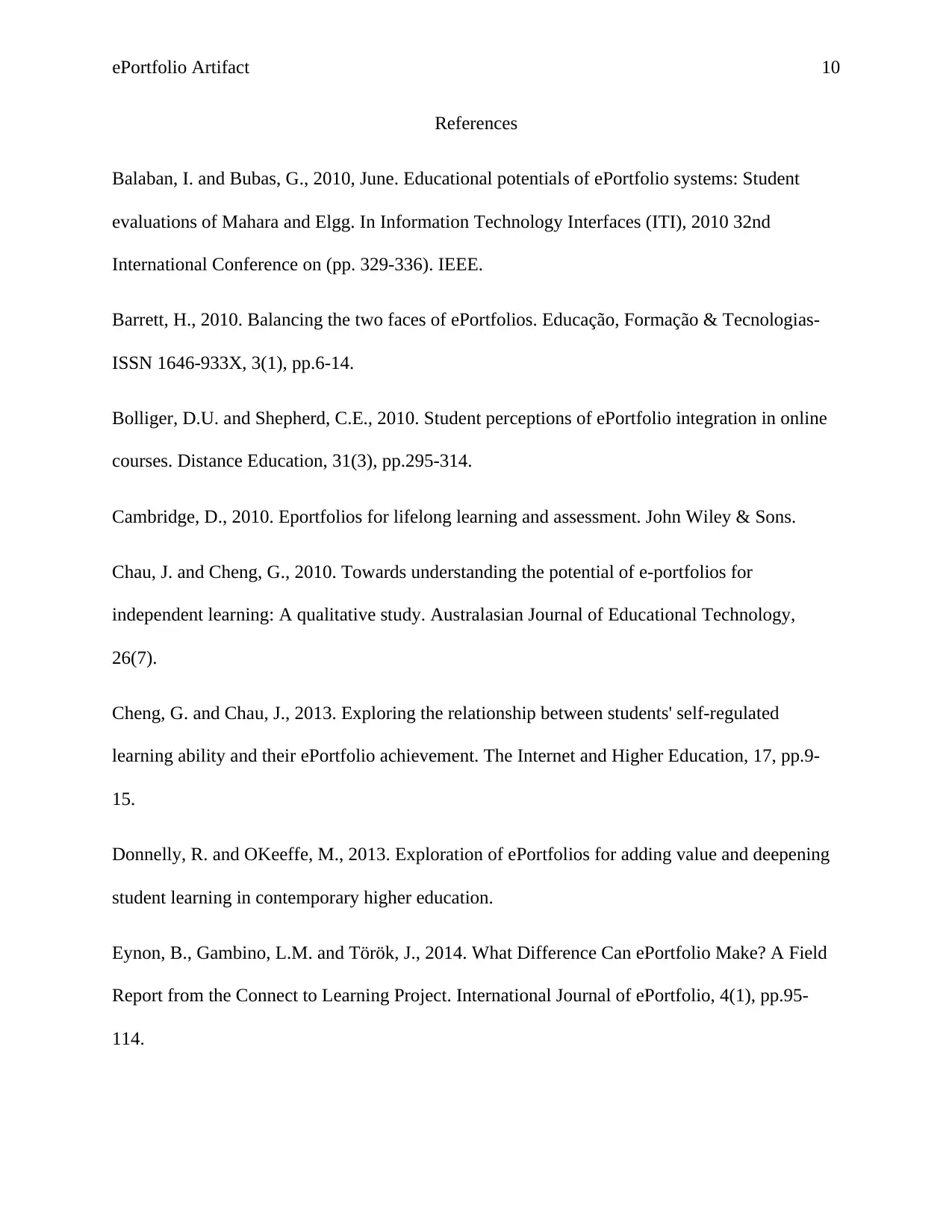
ePortfolio Artifact 10
References
Balaban, I. and Bubas, G., 2010, June. Educational potentials of ePortfolio systems: Student
evaluations of Mahara and Elgg. In Information Technology Interfaces (ITI), 2010 32nd
International Conference on (pp. 329-336). IEEE.
Barrett, H., 2010. Balancing the two faces of ePortfolios. Educação, Formação & Tecnologias-
ISSN 1646-933X, 3(1), pp.6-14.
Bolliger, D.U. and Shepherd, C.E., 2010. Student perceptions of ePortfolio integration in online
courses. Distance Education, 31(3), pp.295-314.
Cambridge, D., 2010. Eportfolios for lifelong learning and assessment. John Wiley & Sons.
Chau, J. and Cheng, G., 2010. Towards understanding the potential of e-portfolios for
independent learning: A qualitative study. Australasian Journal of Educational Technology,
26(7).
Cheng, G. and Chau, J., 2013. Exploring the relationship between students' self-regulated
learning ability and their ePortfolio achievement. The Internet and Higher Education, 17, pp.9-
15.
Donnelly, R. and OKeeffe, M., 2013. Exploration of ePortfolios for adding value and deepening
student learning in contemporary higher education.
Eynon, B., Gambino, L.M. and Török, J., 2014. What Difference Can ePortfolio Make? A Field
Report from the Connect to Learning Project. International Journal of ePortfolio, 4(1), pp.95-
114.
References
Balaban, I. and Bubas, G., 2010, June. Educational potentials of ePortfolio systems: Student
evaluations of Mahara and Elgg. In Information Technology Interfaces (ITI), 2010 32nd
International Conference on (pp. 329-336). IEEE.
Barrett, H., 2010. Balancing the two faces of ePortfolios. Educação, Formação & Tecnologias-
ISSN 1646-933X, 3(1), pp.6-14.
Bolliger, D.U. and Shepherd, C.E., 2010. Student perceptions of ePortfolio integration in online
courses. Distance Education, 31(3), pp.295-314.
Cambridge, D., 2010. Eportfolios for lifelong learning and assessment. John Wiley & Sons.
Chau, J. and Cheng, G., 2010. Towards understanding the potential of e-portfolios for
independent learning: A qualitative study. Australasian Journal of Educational Technology,
26(7).
Cheng, G. and Chau, J., 2013. Exploring the relationship between students' self-regulated
learning ability and their ePortfolio achievement. The Internet and Higher Education, 17, pp.9-
15.
Donnelly, R. and OKeeffe, M., 2013. Exploration of ePortfolios for adding value and deepening
student learning in contemporary higher education.
Eynon, B., Gambino, L.M. and Török, J., 2014. What Difference Can ePortfolio Make? A Field
Report from the Connect to Learning Project. International Journal of ePortfolio, 4(1), pp.95-
114.
Paraphrase This Document
Need a fresh take? Get an instant paraphrase of this document with our AI Paraphraser
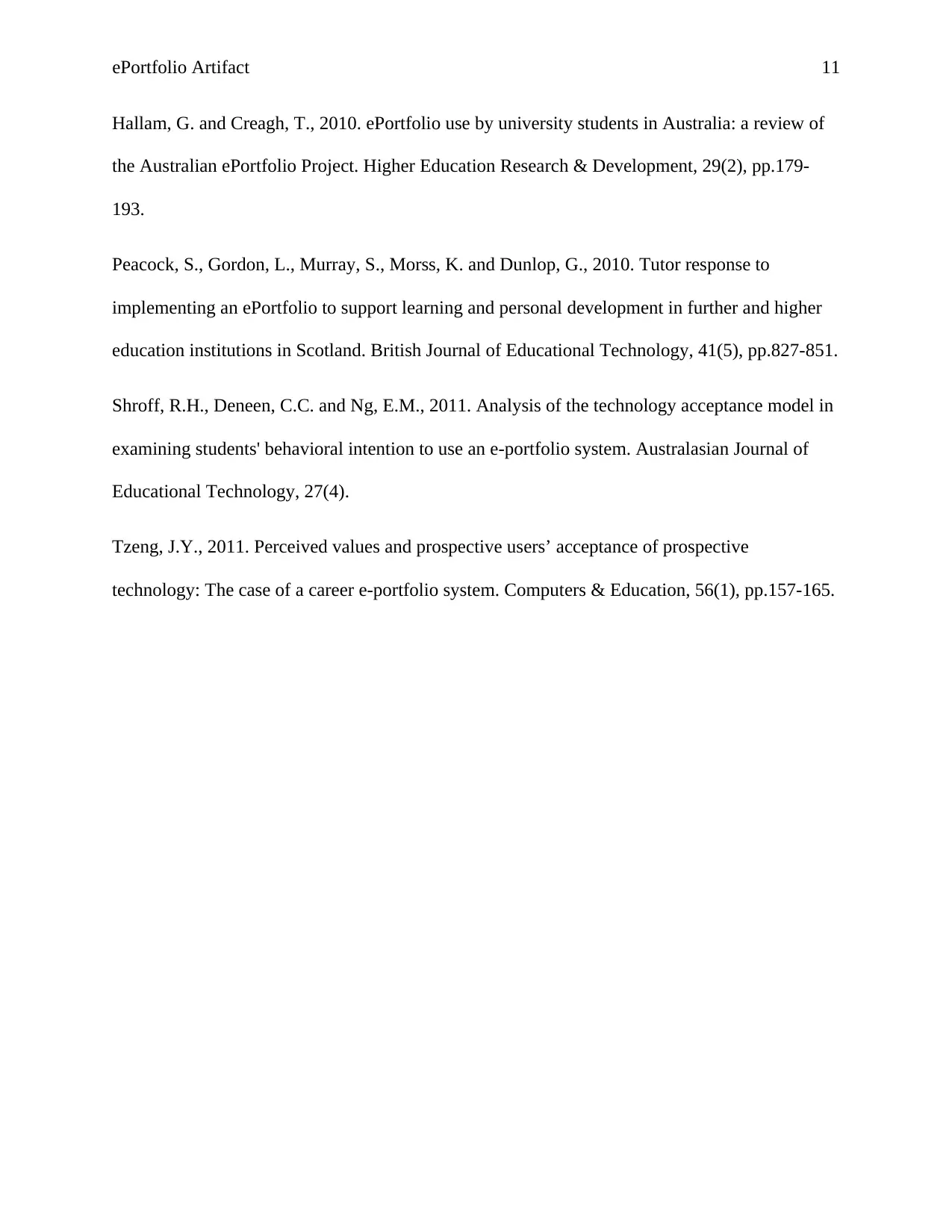
ePortfolio Artifact 11
Hallam, G. and Creagh, T., 2010. ePortfolio use by university students in Australia: a review of
the Australian ePortfolio Project. Higher Education Research & Development, 29(2), pp.179-
193.
Peacock, S., Gordon, L., Murray, S., Morss, K. and Dunlop, G., 2010. Tutor response to
implementing an ePortfolio to support learning and personal development in further and higher
education institutions in Scotland. British Journal of Educational Technology, 41(5), pp.827-851.
Shroff, R.H., Deneen, C.C. and Ng, E.M., 2011. Analysis of the technology acceptance model in
examining students' behavioral intention to use an e-portfolio system. Australasian Journal of
Educational Technology, 27(4).
Tzeng, J.Y., 2011. Perceived values and prospective users’ acceptance of prospective
technology: The case of a career e-portfolio system. Computers & Education, 56(1), pp.157-165.
Hallam, G. and Creagh, T., 2010. ePortfolio use by university students in Australia: a review of
the Australian ePortfolio Project. Higher Education Research & Development, 29(2), pp.179-
193.
Peacock, S., Gordon, L., Murray, S., Morss, K. and Dunlop, G., 2010. Tutor response to
implementing an ePortfolio to support learning and personal development in further and higher
education institutions in Scotland. British Journal of Educational Technology, 41(5), pp.827-851.
Shroff, R.H., Deneen, C.C. and Ng, E.M., 2011. Analysis of the technology acceptance model in
examining students' behavioral intention to use an e-portfolio system. Australasian Journal of
Educational Technology, 27(4).
Tzeng, J.Y., 2011. Perceived values and prospective users’ acceptance of prospective
technology: The case of a career e-portfolio system. Computers & Education, 56(1), pp.157-165.
1 out of 11
Related Documents
Your All-in-One AI-Powered Toolkit for Academic Success.
+13062052269
info@desklib.com
Available 24*7 on WhatsApp / Email
![[object Object]](/_next/static/media/star-bottom.7253800d.svg)
Unlock your academic potential
Copyright © 2020–2025 A2Z Services. All Rights Reserved. Developed and managed by ZUCOL.





